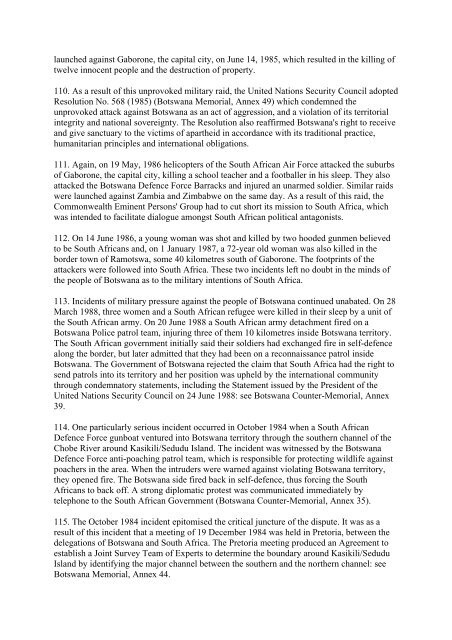botswana/namibia - Cour international de Justice
botswana/namibia - Cour international de Justice
botswana/namibia - Cour international de Justice
You also want an ePaper? Increase the reach of your titles
YUMPU automatically turns print PDFs into web optimized ePapers that Google loves.
launched against Gaborone, the capital city, on June 14, 1985, which resulted in the killing of<br />
twelve innocent people and the <strong>de</strong>struction of property.<br />
110. As a result of this unprovoked military raid, the United Nations Security Council adopted<br />
Resolution No. 568 (1985) (Botswana Memorial, Annex 49) which con<strong>de</strong>mned the<br />
unprovoked attack against Botswana as an act of aggression, and a violation of its territorial<br />
integrity and national sovereignty. The Resolution also reaffirmed Botswana's right to receive<br />
and give sanctuary to the victims of apartheid in accordance with its traditional practice,<br />
humanitarian principles and <strong>international</strong> obligations.<br />
111. Again, on 19 May, 1986 helicopters of the South African Air Force attacked the suburbs<br />
of Gaborone, the capital city, killing a school teacher and a footballer in his sleep. They also<br />
attacked the Botswana Defence Force Barracks and injured an unarmed soldier. Similar raids<br />
were launched against Zambia and Zimbabwe on the same day. As a result of this raid, the<br />
Commonwealth Eminent Persons' Group had to cut short its mission to South Africa, which<br />
was inten<strong>de</strong>d to facilitate dialogue amongst South African political antagonists.<br />
112. On 14 June 1986, a young woman was shot and killed by two hoo<strong>de</strong>d gunmen believed<br />
to be South Africans and, on 1 January 1987, a 72-year old woman was also killed in the<br />
bor<strong>de</strong>r town of Ramotswa, some 40 kilometres south of Gaborone. The footprints of the<br />
attackers were followed into South Africa. These two inci<strong>de</strong>nts left no doubt in the minds of<br />
the people of Botswana as to the military intentions of South Africa.<br />
113. Inci<strong>de</strong>nts of military pressure against the people of Botswana continued unabated. On 28<br />
March 1988, three women and a South African refugee were killed in their sleep by a unit of<br />
the South African army. On 20 June 1988 a South African army <strong>de</strong>tachment fired on a<br />
Botswana Police patrol team, injuring three of them 10 kilometres insi<strong>de</strong> Botswana territory.<br />
The South African government initially said their soldiers had exchanged fire in self-<strong>de</strong>fence<br />
along the bor<strong>de</strong>r, but later admitted that they had been on a reconnaissance patrol insi<strong>de</strong><br />
Botswana. The Government of Botswana rejected the claim that South Africa had the right to<br />
send patrols into its territory and her position was upheld by the <strong>international</strong> community<br />
through con<strong>de</strong>mnatory statements, including the Statement issued by the Presi<strong>de</strong>nt of the<br />
United Nations Security Council on 24 June 1988: see Botswana Counter-Memorial, Annex<br />
39.<br />
114. One particularly serious inci<strong>de</strong>nt occurred in October 1984 when a South African<br />
Defence Force gunboat ventured into Botswana territory through the southern channel of the<br />
Chobe River around Kasikili/Sedudu Island. The inci<strong>de</strong>nt was witnessed by the Botswana<br />
Defence Force anti-poaching patrol team, which is responsible for protecting wildlife against<br />
poachers in the area. When the intru<strong>de</strong>rs were warned against violating Botswana territory,<br />
they opened fire. The Botswana si<strong>de</strong> fired back in self-<strong>de</strong>fence, thus forcing the South<br />
Africans to back off. A strong diplomatic protest was communicated immediately by<br />
telephone to the South African Government (Botswana Counter-Memorial, Annex 35).<br />
115. The October 1984 inci<strong>de</strong>nt epitomised the critical juncture of the dispute. It was as a<br />
result of this inci<strong>de</strong>nt that a meeting of 19 December 1984 was held in Pretoria, between the<br />
<strong>de</strong>legations of Botswana and South Africa. The Pretoria meeting produced an Agreement to<br />
establish a Joint Survey Team of Experts to <strong>de</strong>termine the boundary around Kasikili/Sedudu<br />
Island by i<strong>de</strong>ntifying the major channel between the southern and the northern channel: see<br />
Botswana Memorial, Annex 44.

















